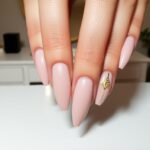The first time I found henna, it felt like discovering a secret world of art. My hands shook with excitement as I saw how simple designs could turn skin into a work of art. Whether you’re new to henna or interested in traditional art, beginner designs are a great start.
Henna art is more than just decoration; it’s a cultural celebration that brings people together. By exploring creative design techniques, you’ll enter an ancient tradition that speaks volumes silently. Simple henna designs are perfect for anyone wanting to learn this captivating craft.
Imagine making stunning patterns that show off your style, even if you’re new to henna. You can create everything from delicate flowers to geometric shapes. Beginner henna designs open up a world of artistic possibilities.
As you start this journey, remember that each line tells a story. Your hands will become a canvas, ready to display the beauty of henna’s traditional and modern techniques.
Table of Contents
Understanding the Basics of Henna Art
Henna art is a beautiful form of body decoration with deep roots. It spans centuries and continents. Creating stunning henna tattoo ideas is more than decoration; it’s a way to express yourself.
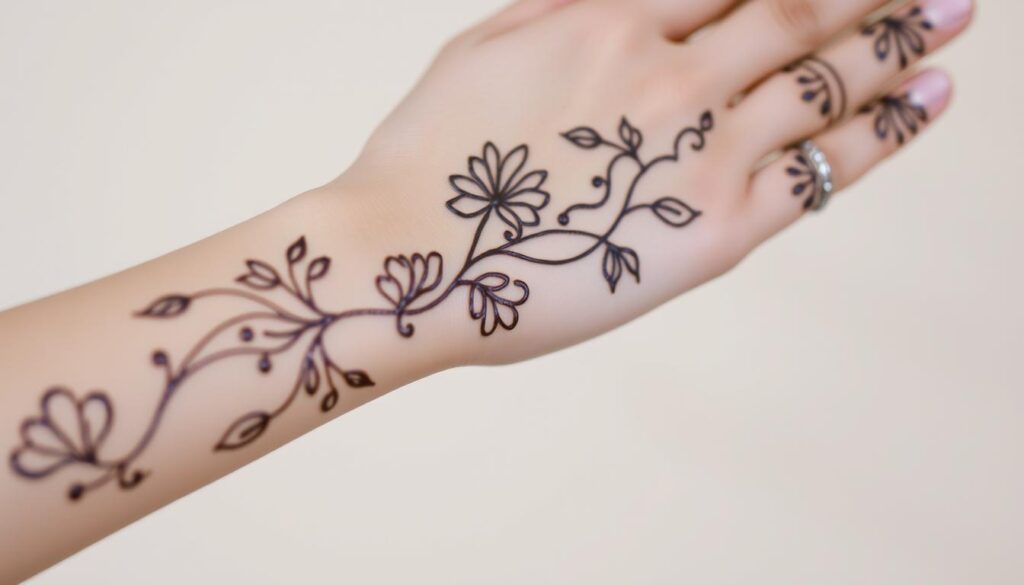
Henna comes from ancient civilizations. It’s made from the lawsonia inermis plant. The leaves are dried and ground into powder. This powder is mixed into a paste for artists to create designs.
Cultural Significance of Henna
Henna is deeply meaningful in many cultures. It’s especially important in:
- South Asian wedding traditions
- Middle Eastern celebrations
- North African cultural ceremonies
Essential Tools for Henna Application
| Tool | Purpose | Recommended Type |
|---|---|---|
| Henna Cone | Application of design | Plastic disposable cones |
| Mixing Bowl | Preparing henna paste | Non-metallic ceramic bowl |
| Applicator Tip | Creating fine lines | Thin plastic nozzle |
When looking at creative henna tattoo ideas, quality tools are key. Professional-grade materials help you create smooth, precise designs.
“Henna is more than art – it’s a connection to tradition and personal expression.” – Traditional Henna Artist
Whether for a special occasion or a new skill, learning about henna is essential. It helps you create designs that tell your story.
Getting Started: Preparing for Your First Henna Design
Starting your henna art journey needs careful prep. To create easy henna patterns, you must first understand the basics. This guide will help you get ready to make beautiful quick henna designs.
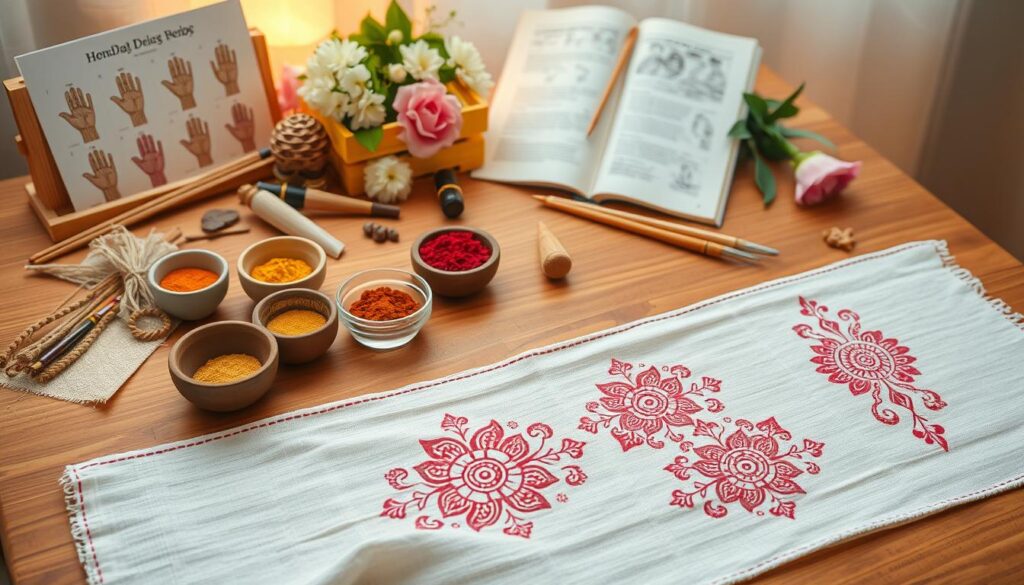
Skin Preparation Techniques
Getting your skin ready is key for stunning henna art. Here are the essential steps:
- Cleanse the skin with soap and water
- Gently exfoliate to remove dead skin cells
- Make sure the skin is dry before applying
- Apply a thin layer of eucalyptus oil to extend the design’s life
“A clean canvas is the secret to perfect henna designs” – Traditional Henna Artist
Mixing and Consistency of Henna Paste
For easy henna patterns, the paste must be just right. It should be smooth, like toothpaste, for quick designs.
| Ingredient | Proportion | Purpose |
|---|---|---|
| Henna Powder | 100g | Base of the paste |
| Lemon Juice | 50ml | Helps release color |
| Essential Oil | 10ml | Improves consistency |
Here are some tips for the perfect henna paste:
- Sift the henna powder to remove lumps
- Mix slowly to avoid clumps
- Let it rest for 4-6 hours before use
- Check the consistency by making a smooth cone
Remember, practice makes perfect when preparing your henna paste for beautiful, intricate designs!
Mastering Basic Henna Strokes and Shapes
Learning simple henna designs starts with basic strokes and shapes. These skills help you make beautiful designs with ease and accuracy.

Starting your henna art journey means mastering essential strokes. Think of these strokes as the alphabet of henna. Each stroke is a building block for more complex designs.
Essential Strokes for Beginners
Every henna artist starts with these core strokes:
- Straight lines
- Curved lines
- Dots and points
- Spiral movements
- Connecting techniques
Simple Geometric Shapes to Practice
Geometric shapes are the base of many simple henna designs. Here’s a guide to practicing these shapes:
| Shape | Difficulty Level | Practice Technique |
|---|---|---|
| Circles | Beginner | Start with small, controlled circular movements |
| Triangles | Easy | Practice consistent angle formations |
| Squares | Intermediate | Focus on precise right-angle connections |
“Precision in simple henna designs comes from patient practice and understanding basic geometric principles.”
As you get better, remember that consistency is key. Your hand control will get better with each stroke. This lets you make more detailed designs.
Try different pressures, angles, and flow to find your style. This will help you grow in your henna art.
Easy Floral Henna Patterns for Beginners
Starting with henna art is exciting, especially with beginner designs. Floral patterns are a great way to begin. They let you create beautiful small designs that show your creativity.
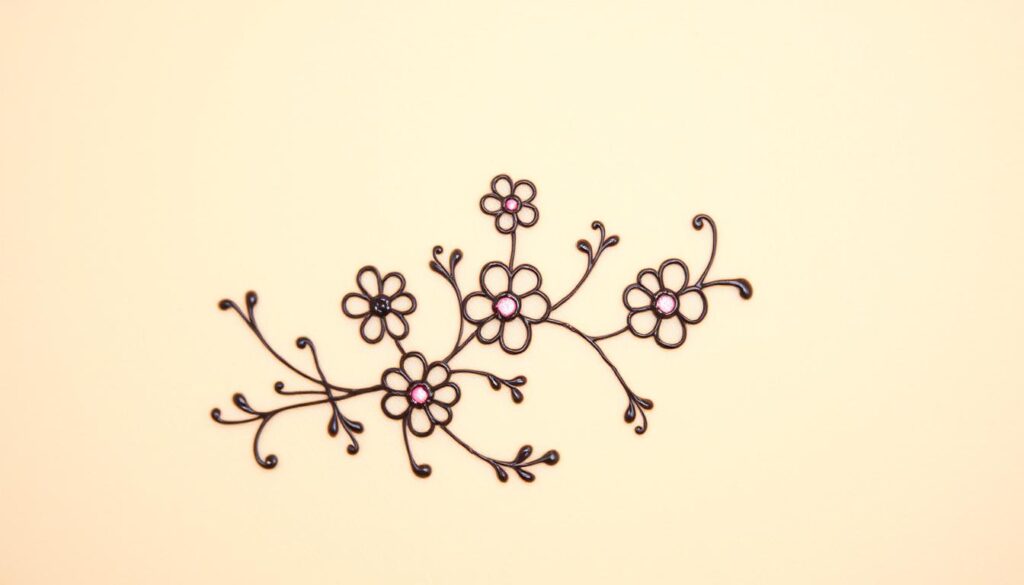
Fundamental Flower Design Techniques
Begin with basic shapes to build confidence in floral henna patterns. Your first flower designs can be simple yet elegant. Here are key techniques to master:
- Begin with circular center points
- Create delicate petal formations
- Use consistent line thickness
- Practice symmetrical designs
Building Your Floral Henna Vocabulary
Learn to make different flower styles with these essential elements. Try out various petal shapes and arrangements to find your unique style.
| Flower Type | Difficulty Level | Key Characteristics |
|---|---|---|
| Simple Daisy | Beginner | Round center, uniform petals |
| Rose-Inspired Pattern | Intermediate | Layered, curved petals |
| Lotus Design | Advanced | Intricate layering, symbolic meaning |
Incorporating Leaves and Vines
To make your small henna designs better, add leaves and vines. These elements add depth and flow to your art.
“Every flower is a soul blossoming in nature” – Gerard De Nerval
Remember, practice is key. Start with simple designs and get more complex as you get better at henna art.
Minimalist Geometric Henna Designs
Minimalistic henna designs open a world of creativity for all. Geometric patterns bring a modern twist to traditional henna. They use simple shapes and lines to create stunning designs.

Basic henna designs based on geometry make your art simple yet elegant. Geometric patterns are great for beginners. They offer many benefits:
- Easier to learn and reproduce
- Create visual symmetry with minimal effort
- Work well on different body parts
- Adapt to various skill levels
Creating Simple Mandala Patterns
Mandalas are a great starting point for minimalistic henna artwork. These circular patterns use shapes and symmetry to create stunning visuals. Start with a central point and add shapes like circles and triangles.
*”Simplicity is the ultimate sophistication in henna design.”*
Linear and Angular Designs for a Modern Look
Today’s henna artists love linear and angular designs. These designs use sharp lines and shapes for a modern look. They give traditional body art a sleek, urban feel.
Focus on making clean lines and precise angles. Remember, negative space is as important as detailed work in basic henna designs.
Quick and Easy Henna Designs for Busy Beginners
If you’re new to henna art and short on time, don’t worry! Quick henna designs are perfect for beginners. They let you explore this beautiful artistic tradition without spending hours.

Mastering small henna designs can be both fun and accessible. These compact patterns are ideal for those wanting to practice their skills. They’re also great for adding a touch of artistic flair to your day.
5-Minute Henna Patterns
Creating beautiful henna art doesn’t have to be time-consuming. Here are some quick henna designs you can complete in just a few minutes:
- Simple dot and line patterns
- Minimalist geometric shapes
- Basic flower outlines
- Delicate swirl designs
Designs for Small Body Parts
Small henna designs work perfectly on fingers, wrists, and ankles. These areas are great for practicing. They also allow you to create elegant, subtle art.
| Body Part | Design Complexity | Estimated Time |
|---|---|---|
| Fingers | Very Simple | 3-5 minutes |
| Wrists | Simple to Moderate | 5-10 minutes |
| Ankles | Simple Patterns | 5-7 minutes |
“The beauty of henna lies not in complexity, but in the elegance of simple designs.”
Pro tip: Practice your quick henna designs on paper first. This will help you build confidence and muscle memory. Then, you can apply them to your skin.
Combining Elements: Creating Your Own Simple Henna Designs
Creating your own henna art is a fun journey of creativity and self-expression. Simple henna designs are more than just copying patterns. They’re about mixing elements to make something truly personal.
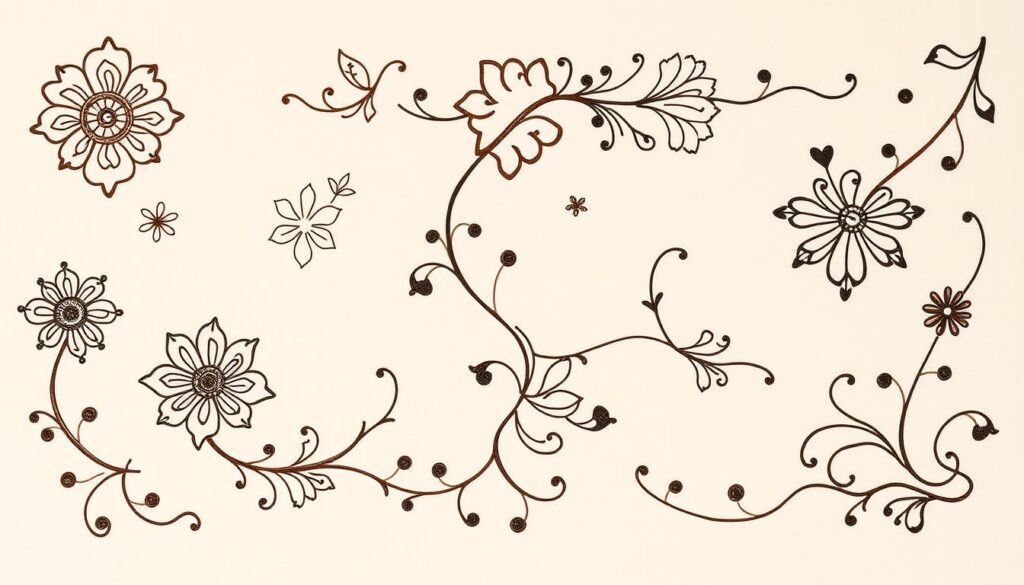
When looking at henna tattoo ideas, start by learning the basics of design. Your creativity will grow as you mix and match basic patterns with confidence.
Mixing and Matching Basic Patterns
To make stunning simple henna designs, try these tips:
- Begin with a central focal point like a flower or geometric shape
- Add elements around the central design that complement it
- Play with different stroke weights and textures
- Practice blending linear and curved patterns smoothly
Tips for Balanced and Harmonious Designs
To balance your henna tattoo ideas, think carefully. Symmetry is not just mirroring. It’s about creating harmony through placement and proportion.
“In henna art, every line tells a story. Your design should flow like poetry across the skin.”
Practice linking different design elements smoothly. Use negative space to avoid overcrowding. Remember, simplicity can be as powerful as intricate details in simple henna designs.
Henna Application Techniques for Smooth Lines and Even Coverage
Mastering henna application takes precision and practice. Whether you’re doing easy henna patterns or basic designs, knowing the right techniques is key. It can turn your work from amateur to professional.
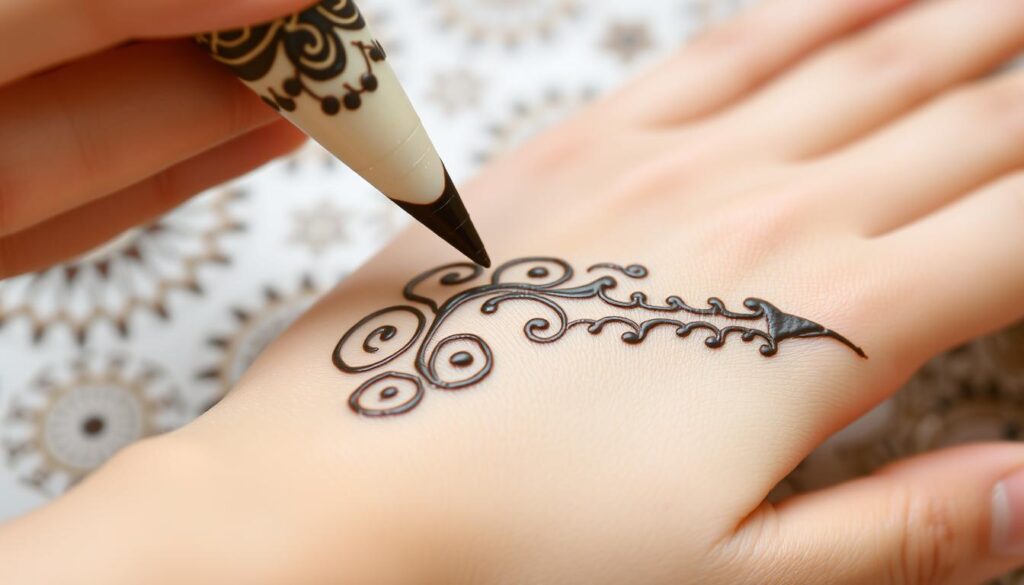
Getting good at henna application means mastering several skills. The quality of your design isn’t just about creativity. It’s also about how well you execute it.
Proper Cone Handling Techniques
Handling the henna cone right is crucial for smooth designs. Your grip and pressure affect the line quality and design look. Here are some tips to keep in mind:
- Hold the henna cone between your thumb and first two fingers
- Maintain a consistent, gentle pressure
- Keep your hand steady and movements controlled
- Practice creating uniform line thickness
Pressure Control for Precise Designs
Controlling pressure is key for the thickness and definition of your designs. Different pressures create different line styles:
| Pressure Level | Line Characteristics | Best Used For |
|---|---|---|
| Light Pressure | Thin, delicate lines | Intricate details |
| Medium Pressure | Consistent, balanced lines | Standard design elements |
| Heavy Pressure | Bold, thick lines | Geometric shapes |
Troubleshooting Common Application Issues
Even pros face challenges with henna designs. Common issues include:
- Uneven line thickness
- Cone leakage
- Shaky hand movements
- Inconsistent paste consistency
“Practice makes perfect. Every imperfect design is a step toward mastering henna art.”
By focusing on technique, keeping your hands steady, and practicing, you’ll get better. You’ll be able to create stunning henna designs with confidence.
Aftercare and Maintenance of Your Henna Designs
Creating beautiful henna tattoo ideas is just the start. Proper aftercare makes your designs vibrant and long-lasting. Understanding how to preserve and care for your henna art is key.
Proper Drying and Setting Techniques
Patience is essential after applying henna. The first few hours are crucial for a rich color. Follow these steps:
- Let the henna paste dry completely without touching or rubbing
- Avoid washing the area for at least 6-8 hours
- Keep the design warm to help intensify the color
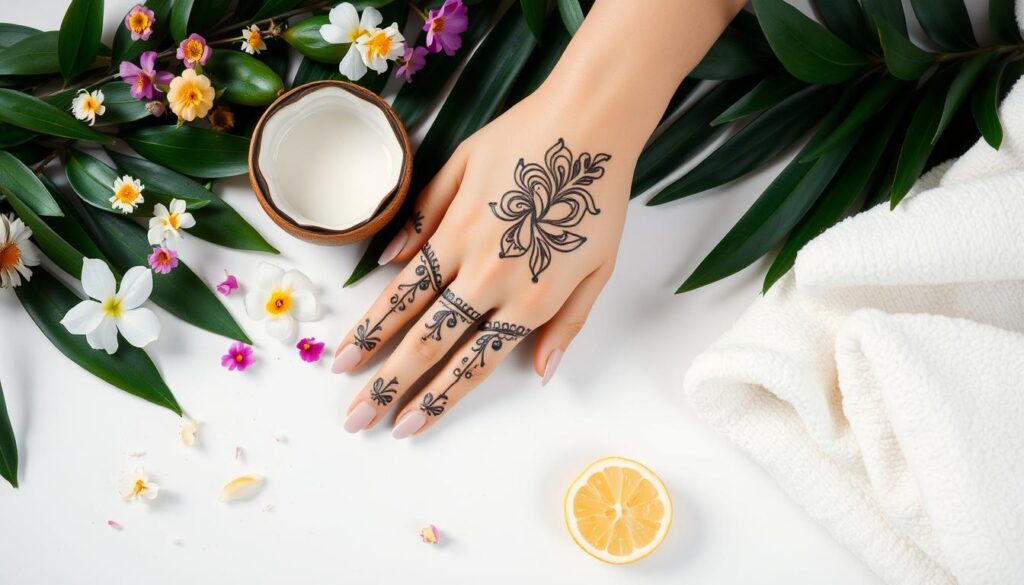
Tips for Longer-Lasting Henna Stains
Here are expert tips to make your henna designs last longer:
| Technique | Impact on Henna Stain |
|---|---|
| Apply essential oils | Helps darken and prolong stain |
| Avoid water contact | Prevents premature fading |
| Use lemon-sugar solution | Enhances color intensity |
“The art of henna is not just in the application, but in the careful maintenance of your design.” – Henna Artist
Natural care methods can make your henna tattoo ideas last longer. Moisturizing the design with coconut oil preserves the patterns and keeps the skin healthy.
Inspiration and Resources for Simple Henna Designs
Starting your henna art journey is exciting. You can find simple designs and patterns online. Many resources will help you grow your skills and creativity.
Discovering Online Henna Communities
The internet is full of henna inspiration. Sites like Pinterest and Instagram have thousands of designs. With over 4,000 searches for simple symbols, you’ll find lots of motivation.
- Instagram henna art hashtags
- Pinterest henna design boards
- Online henna artist forums
Essential Books and Tutorials for Beginners
Learning henna design takes good resources. Turkish mehndi designs mix traditional Middle Eastern styles with modern art. Here are some recommended resources:
| Resource Type | Recommended Focus |
|---|---|
| Books | Comprehensive henna design techniques |
| Online Tutorials | Step-by-step simple henna patterns |
| Video Courses | Advanced technique learning |
“Every great artist was first an amateur” – Ralph Waldo Emerson
Your henna design journey is unique. With practice and the right resources, you’ll grow confident. You’ll create beautiful, easy patterns that show your style.
Taking Your Henna Skills to the Next Level
As you keep going on your henna art journey, you’ll find new ways to make your designs better. The skills you’ve learned are just the start of a creative journey. Professional henna artists say to keep pushing yourself with more complex patterns.
Try out different henna tattoo ideas from around the world. Indian, Moroccan, and Arabic styles each have their own special ways of designing. You might learn traditional patterns from places like Rajasthan or try modern designs that mix old and new. Keep practicing to get better at your craft.
There’s also a chance to grow as a henna artist. Look into workshops, follow famous henna artists on social media, and try out new techniques. As you get better, you might start henna parties, join cultural events, or even start your own business.
Remember, getting better takes time and always learning. Every design you make shows how much you’ve grown. Stay open to new ideas, try different styles, and love the process of making your own henna art.







